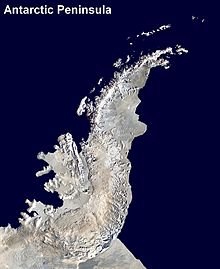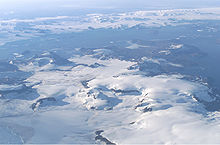User:Lgkirst/Tectonics of the Antarctic Peninsula


The Antarctic Peninsula, just 650 miles south of South America is the most northerly portion of the continent of Antarctica. Essentially a continuation of the Andes Mountains subduction zone, the Antarctic Peninsula exhibits textbook subduction zone tectonic activity. The geologic and tectonic history of the Antarctic Peninsula spans millions of years. Throughout this span of time the plate configurations that essentially formed the Antarctic Peninsula shifted. These shifts changed the orientation of the peninsula itself, as well as the underlying volcanics associated with the subduction zone.[1]
Geologic history of the Antarctic Peninsula[edit]
The geology of the Antarctic Peninsula has occurred within three different stages:
- Pre-subduction stage of marginal basin deposition, later seperated by the Gondwanian orogeny,Permian-Late Triassic
- The formation of two magmatic arcs, one proximal and one distal to the peninsula during the main subduction stage, middle Jurassic-Miocene.
- The late subduction phase where the Bransfield Rift opens along with the back-arc basin, site of contemporaneous terrestrial and submarine volcanic activity, Oligocene-present day.

Pre-Subduction History[edit]
The oldest rocks found on the Antarctic Peninsula are from this time. They are sedimentary rocks from the Trinity Peninsula Group(TPG). Mostly composed of siliciclastic turbidite deposits ~1200-3000m thick deposited in a marginal marine basin.[1] Unfortunately their age is poorly known, but are most likely from the upper Permian and Triassic. The clastic material used to create these sediments was provided by the weathering, erosion, and subsequent transportation of Gondwanaland to the northeast. Source rocks assemblage was most likely a mixture of metamorphic, igneous, and sedimentary complexes.[1]
Gondwanian orogeny[edit]
At this time the TPG sediments were folded and slightly metamorphosed, particularly at the peninsula's northernmost point. Retroarc thrusting was also occurring at that time. Both events were most likely caused by incipient stage subduction of the south-east Pacific Plate under the Gondwana supercontinent. As a result, marginal basin clastics were scraped from their oceanic crustal base and subsequently antithetic piling-up of the TPG sediments occured. These were then thrusted over the continental margin of Gondwanaland. It is believed that the TPG rocks were uprooted from their original oceanic-type basement and are allochthonous with respect to underlying crystalline basement rock of the Antarctic Peninsula.[1]
| Una's Tits | |
|---|---|
 Una's Tits, Lemaire Channel, January 2010 | |
| Highest point | |
| Elevation | 747 m (2,451 ft) |
| Listing | Breast shaped hills |
| Coordinates | 65°06′24″S 63°56′26″W / 65.10667°S 63.94056°W |
| Geography | |
| Climbing | |
| First ascent | 1999 |
References[edit]
- ^ a b c d Birkenmajer, K. (1994). "Evolution of the Pacific margin of the northern Antarctic Peninsula: An overview". International Journal of Earth Sciences. 83 (2): 309–321. Bibcode:1994GeoRu..83..309B. doi:10.1007/BF00210547 (inactive 2022-06-26).
{{cite journal}}: CS1 maint: DOI inactive as of June 2022 (link)

